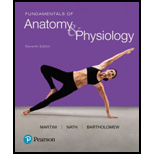
Fundamentals of Anatomy & Physiology (11th Edition)
11th Edition
ISBN: 9780134396026
Author: Frederic H. Martini, Judi L. Nath, Edwin F. Bartholomew
Publisher: PEARSON
expand_more
expand_more
format_list_bulleted
Question
Chapter 19, Problem 1CC
Summary Introduction
To determine:
The reason for the pain in Clare’s body.
Introduction:
Sickle cell disease or SCD is a disease in which the RBCs of the blood are not cup shaped, but are sickle shaped. This disease helped in preventing the malarial
Expert Solution & Answer
Trending nowThis is a popular solution!

Students have asked these similar questions
What is behavioral adapt
22. Which of the following mutant proteins is expected to have a dominant negative effect when over-
expressed in normal cells?
a. mutant PI3-kinase that lacks the SH2 domain but retains the kinase function
b. mutant Grb2 protein that cannot bind to RTK
c. mutant RTK that lacks the extracellular domain
d. mutant PDK that has the PH domain but lost the kinase function
e. all of the above
What is the label ?
Chapter 19 Solutions
Fundamentals of Anatomy & Physiology (11th Edition)
Ch. 19 - List five major functions of blood.Ch. 19 - Identify the three types of formed elements in...Ch. 19 - Prob. 3CPCh. 19 - What would be the effects of a decrease in the...Ch. 19 - Prob. 5CPCh. 19 - Prob. 6CPCh. 19 - Prob. 7CPCh. 19 - How would liver disease affect the level of...Ch. 19 - Prob. 9CPCh. 19 - Prob. 10CP
Ch. 19 - Prob. 11CPCh. 19 - Prob. 12CPCh. 19 - Prob. 13CPCh. 19 - Prob. 14CPCh. 19 - Prob. 15CPCh. 19 - Prob. 16CPCh. 19 - List the three primary functions of platelets.Ch. 19 - Prob. 18CPCh. 19 - Prob. 19CPCh. 19 - Prob. 20CPCh. 19 - Prob. 1RQCh. 19 - The formed elements of the blood include (a)...Ch. 19 - Prob. 3RQCh. 19 - Prob. 4RQCh. 19 - Prob. 5RQCh. 19 - Prob. 6RQCh. 19 - Prob. 7RQCh. 19 - Stem cells responsible for lymphocytopoiesis are...Ch. 19 - ______ and _______ affect almost every aspect of...Ch. 19 - Prob. 10RQCh. 19 - Prob. 11RQCh. 19 - Prob. 12RQCh. 19 - Prob. 13RQCh. 19 - Prob. 14RQCh. 19 - Prob. 15RQCh. 19 - Prob. 16RQCh. 19 - Prob. 17RQCh. 19 - Prob. 18RQCh. 19 - Prob. 19RQCh. 19 - Prob. 20RQCh. 19 - Prob. 21RQCh. 19 - Prob. 22RQCh. 19 - Prob. 23RQCh. 19 - Prob. 24RQCh. 19 - Prob. 25RQCh. 19 - Relate the structure of hemoglobin to its...Ch. 19 - Prob. 27RQCh. 19 - Prob. 28RQCh. 19 - Prob. 29RQCh. 19 - Prob. 30RQCh. 19 - Prob. 31RQCh. 19 - Prob. 1CCCh. 19 - Prob. 2CC
Knowledge Booster
Learn more about
Need a deep-dive on the concept behind this application? Look no further. Learn more about this topic, biology and related others by exploring similar questions and additional content below.Similar questions
- Can you described the image? Can you explain the question as well their answer and how to get to an answer to an problem like this?arrow_forwardglg 112 mid unit assignment Identifying melting processesarrow_forwardGive only the mode of inheritance consistent with all three pedigrees and only two reasons that support this, nothing more, (it shouldn't take too long)arrow_forward
- Oarrow_forwardDescribe the principle of homeostasis.arrow_forwardExplain how the hormones of the glands listed below travel around the body to target organs and tissues : Pituitary gland Hypothalamus Thyroid Parathyroid Adrenal Pineal Pancreas(islets of langerhans) Gonads (testes and ovaries) Placentaarrow_forward
- What are the functions of the hormones produced in the glands listed below: Pituitary gland Hypothalamus Thyroid Parathyroid Adrenal Pineal Pancreas(islets of langerhans) Gonads (testes and ovaries) Placentaarrow_forwardDescribe the hormones produced in the glands listed below: Pituitary gland Hypothalamus Thyroid Parathyroid Adrenal Pineal Pancreas(islets of langerhans) Gonads (testes and ovaries) Placentaarrow_forwardPlease help me calculate drug dosage from the following information: Patient weight: 35 pounds, so 15.9 kilograms (got this by dividing 35 pounds by 2.2 kilograms) Drug dose: 0.05mg/kg Drug concentration: 2mg/mLarrow_forward
- A 25-year-old woman presents to the emergency department with a 2-day history of fever, chills, severe headache, and confusion. She recently returned from a trip to sub-Saharan Africa, where she did not take malaria prophylaxis. On examination, she is febrile (39.8°C/103.6°F) and hypotensive. Laboratory studies reveal hemoglobin of 8.0 g/dL, platelet count of 50,000/μL, and evidence of hemoglobinuria. A peripheral blood smear shows ring forms and banana-shaped gametocytes. Which of the following Plasmodium species is most likely responsible for her severe symptoms? A. Plasmodium vivax B. Plasmodium ovale C. Plasmodium malariae D. Plasmodium falciparumarrow_forwardStandard Concentration (caffeine) mg/L Absorbance Reading 10 0.322 20 0.697 40 1.535 60 2.520 80 3.100arrow_forwardPlease draw in the missing answer, thank youarrow_forward
arrow_back_ios
SEE MORE QUESTIONS
arrow_forward_ios
Recommended textbooks for you
- Health Safety And Nutrition F/Young ChildHealth & NutritionISBN:9781305144767Author:MAROTZPublisher:Cengage
- Case Studies In Health Information ManagementBiologyISBN:9781337676908Author:SCHNERINGPublisher:Cengage



Health Safety And Nutrition F/Young Child
Health & Nutrition
ISBN:9781305144767
Author:MAROTZ
Publisher:Cengage


Case Studies In Health Information Management
Biology
ISBN:9781337676908
Author:SCHNERING
Publisher:Cengage

Complications during Labour and Delivery; Author: FirstCry Parenting;https://www.youtube.com/watch?v=QnCviG4GpYg;License: Standard YouTube License, CC-BY